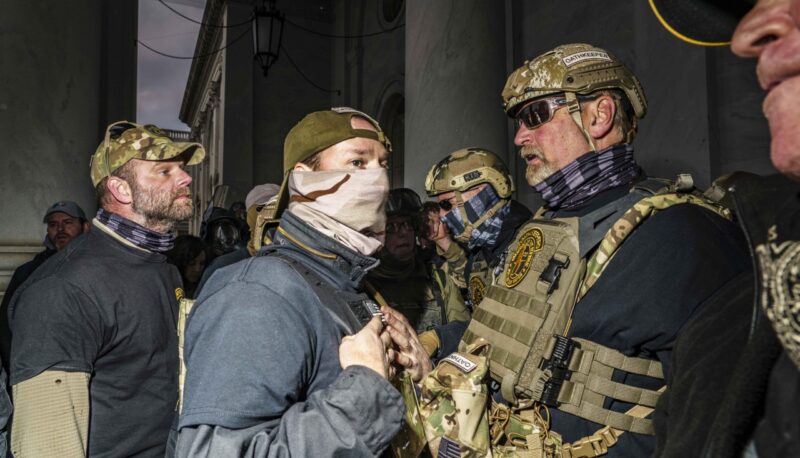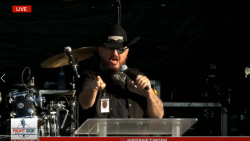A few weeks before the violent attack on the U.S. Capitol, Stewart Rhodes addressed a crowd of “Stop the Steal” activists and other Trump loyalists gathered on the National Mall. Rhodes, the founder of the anti-government extremist group the Oath Keepers, had a message for the president: Trump, Rhodes said, needed to “show the world who the traitors are, and then use the Insurrection Act to drop the hammer on them.”
“He needs to know from you that you are with him, [and] that if he does not do it now while he is commander in chief, we’re going to have to do it ourselves later, in a much more desperate, much more bloody war,” Rhodes threatened.
On Jan. 6, 2021, a “stack” of Oath Keepers decked out in military gear weaved their way through the mob at the U.S. Capitol and forced their way inside, where some battled police and searched for members of Congress.
Nineteen members of the Oath Keepers face federal charges for their actions on Jan. 6. Eleven, including Rhodes, have been charged with seditious conspiracy—accused of trying to “stop, delay, and hinder” the certification of Joe Biden’s election victory. In February, Rhodes testified for six hours in front of the House select committee investigating the Jan. 6 attack on the U.S. Capitol.
The Oath Keepers, along with the Proud Boys and III Percenters, were among the most notable extremist groups at the Capitol that day, acting as the foot soldiers in Trump’s effort to prevent the peaceful transfer of power. Their actions that day illustrate how right-wing activists’ rhetoric of “1776,” “rebellion,” and “civil war” was not just talk but a rallying cry. The select committee’s first public hearing examined how members of the extremist group, along with the Proud Boys, conspired to keep Trump in power and were willing to commit violence for that goal. Here’s what you need to know.
What is the Oath Keepers? Who is Stewart Rhodes?
The Oath Keepers was founded in April 2009, shortly after the election of President Barack Obama. On the Lexington Green in Massachusetts, Rhodes read aloud the oath that members of the newly formed militia would take, vowing to defend the Constitution “from all enemies foreign and domestic.” For the Oath Keepers, the federal government is among those enemies.
The ideology of the Oath Keepers has always been conspiratorial, with leaders asserting that global elites had taken over the federal government and were keen on imposing martial law and, eventually, instituting a “One World Order.” Though the group has been distrustful of the federal government and claims to be nonpartisan, it has aligned itself with the fringes of the Republican Party. By the time Trump came into office, the group came to embrace Trump and see social justice movements like Black Lives Matter as threats.
The Oath Keepers heavily recruits from law enforcement and former military personnel. The group has had as many as 40,000 people on their membership roles, though watchdog groups like the Southern Poverty Law Center and Anti-Defamation League estimate that it only has a few thousand members at any given time.
A leak of membership data last year revealed that at least 28 elected officials have “joined or financially supported” the Oath Keepers, including Republican Alaska state Rep. David Eastman and Arizona state Rep. Mark Finchem, both of whom were in D.C. on Jan. 6.
Rhodes, a veteran, Yale law graduate, and former Ron Paul staffer, has talked about “civil war” since the organization’s founding. His now estranged family describes him as obsessed with the American Revolution and with becoming the next George Washington. His penchant for violent rhetoric was on display in 2015, when Rhodes, seated on a panel with Rep. Andy Biggs, called for the hanging of Sen. John McCain.
Oath Keepers’ Stewart Rhodes Calls for ‘Bloody War’ at Jericho March from Right Wing Watch on Vimeo.
What was the Oath Keepers role ahead of Jan. 6?
Two days after Election Day, Rhodes began a private group chat with leaders of state Oath Keepers chapters. The only way forward, he said, was a civil war. On Nov. 7, 2020—when Trump was projected to have lost the election—Rhodes told the same group that the Oath Keepers that they must “Refuse to accept it and march en-mass[e] on the nation’s Capital.” He called for revolution.
In the ensuing months, Rhodes’ calls for violence grew more public as his group’s plans for action on Jan. 6 took shape in private communications. Those communications are spelled out in detail in federal indictments of Rhodes and other Oath Keepers members on charges of seditious conspiracy.
On Nov. 9, Rhodes held a private online meeting for Oath Keepers members, where he outlined a plan to stop Biden from assuming the presidency, including preparations for the use of force, according to court records.
Leaders of the state chapters responded to the call for action by beginning to recruit others and offering trainings in paramilitary combat tactics. Jessica Watkins—a leader of the Ohio chapter of the Oath Keepers who has since been charged with seditious conspiracy—informed “recruits” of a “military style” basic training they could take to get “fighting fit by inauguration.” The Florida chapter of the Oath Keepers held a training on “unconventional warfare.”
The Oath Keepers also joined the so-called “Stop the Steal” campaign, spreading false stolen-election claims and attending two of the largest rallies held in D.C. in November and December. Ahead of Jan. 6, Rhodes and others discussed plans to provide security for figures aligned with the campaign, including far-right activist Ali Alexander, GOP operative and Trump confidant Roger Stone, former national security adviser Michael Flynn, and radical conspiracy theorist Alex Jones.
By late December, Trump and right-wing activists had their eyes set on Jan. 6. They called on members of Congress to refuse to carry out their duty to certify the election and began pressuring former Vice President Mike Pence in their campaign to unlawfully overturn the election.
During this time, Rhodes continued to call for violence. On Dec. 22, 2020, Rhodes said in an interview that if Biden assumed the presidency, “We will have to do a bloody, massively bloody revolution against them.” He again urged Trump to invoke the Insurrection Act, stating that Jan. 6, 2021, was the “hard constitutional deadline.”
Court documents show that in a Florida Oath Keepers chat in late December, Kelly Meggs, the Florida leader of the Oath Keepers, discussed the group’s plans for Jan. 6. “We need to make those senators very uncomfortable with all of us being a few hundred feet away,” he said.
“I think Congress will screw him [President Trump] over,” Rhodes responded. “The only chance we/he has is if we scare the shit out of them and convince them it will be torches and pitchforks time [if] they don’t do the right thing. But I don’t think they will Iisten.”
The Oath Keepers began privately plotting their D.C. operation. Rhodes appointed Michael Simmons as the operation leader. They stockpiled weapons and stationed a quick reactionary force, or QRF, in a hotel in Virginia to bring weapons to the Capitol. Thomas Caldwell identified the Comfort Inn in Ballston—a 10 minute drive over the Potomac river into D.C.—as the base of operations for the campaign, and another member discussed procuring a boat to deliver weapons to the members in D.C. William Isaacs sent a direct message to another member on Signal and stated his intentions in coming to D.C.: to commit violence against an elected official. (The indictment does not specify who.)
On Jan. 5, Rhodes went into a D.C. parking garage and met with Enrique Tarrio, the chairman of the neo-fascist Proud Boys. The two groups—which had been at odds with each other—had formed “an alliance,” according to Meggs. Also in attendance at the meeting was Kellye SoRelle, an Oath Keepers attorney, Joshua Macias, a scheduled speaker at the “Save America” rally, and Bianca Gracia, a Jan. 6 rally organizer with White House ties.
What happened on Jan. 6?
Before the sun had risen on Jan. 6, Rhodes messaged the “Leadership” chat group on the encrypted-messaging platform Signal. “We will have several well equipped QRFs outside DC. And there are many, many others, from other groups, who will be watching and waiting on the outside in case of worst case scenarios.”
Rhodes made his way to the east side of the Capitol, where he coordinated with operation leader Simmons, Meggs, and others. As the rally drew to a close, Rhodes told the Oath Keepers group that “Patriots” had breached the Capitol. Court records tell an alarming story about what happened next.
Dressed in reinforced vests, helmets, goggles, and tactical gear, Meggs, Jessica Watkins, Joseph Hackett, David Moerschel, and others marched toward the Capitol. Using her phone like a walkie talkie, Watkins told an Oath Keepers group labeled “Stop the Steal J6” that they were 30 to 40 strong. “We are sticking together and sticking to the plan,” she said.

By 2:30 pm, Meggs, Watkins, Hackett, Moerschel, and other members formed a military-style stack, a single file line with each member keeping a hand on the shoulder of the member in front of them. They weaved through the crowd and up the steps of the Rotunda, where Harrelson joined them. They pushed forward as part of the mob that assaulted police officers, throwing objects and spraying chemical weapons, forcing their way into the Capitol. The group entered the Rotunda. From there, they headed down the hallway toward the Senate chambers where they came face to face with a police line guarding the Senate. “Push, push, push!” Watkins commanded. “Get in there, get in there!”
Police sprayed a chemical repellent, forcing the group to retreat to the Rotunda. But soon Meggs, Harrelson, Hackett, and Moerschel began moving toward the House of Representatives on the hunt for House Speaker Nancy Pelosi.
Meanwhile, another group of Oath Keepers watched the scene unfold from their D.C. hotel as they equipped themselves with hard-knuckle tactical gloves, tactical vests, ballistic goggles, radios, chemical sprays, and scissors, and even an 82-pound German Shepherd named Warrior. Joshua James, Roberto Minuta, Brian Ulrich, and others jumped in golf carts, swerving around law enforcement vehicles while livestreaming on Facebook as they drove to the Capitol. Once there, they formed a stack and made their way up the central steps on the east side of the Capitol, entering the same door the earlier group had gone through.
A mob confronted a line of law enforcement officers blocking the entrance to the Rotunda; James and Minuta, who was filming, joined. James grabbed the vest of a police officer, pulling him into the mob, but officers pulled their man back. James managed to briefly break through the line of officers before an officer sprayed him with chemical repellent.
Both groups eventually retreated. They met with Rhodes outside the Capitol, and in a hotel by the Capitol that evening, Rhodes called an individual with access to Trump. Over speaker phone, Rhodes implored the individual to tell Trump to call on the Oath Keepers and other groups like it to keep him in power, one Oath Keeper member who was in the room would later tell prosecutors. Rhodes’ request was reportedly denied.
The Oath Keepers celebrated the attack over dinner in Virginia and discussed next steps. “Patriots entering their own Capitol to send a message to the traitors is NOTHING compared to what’s coming,” Rhodes told the “Leadership Intel” Signal chat.

What has happened since?
The federal government charged 11 Oath Keepers members, including Rhodes, with seditious conspiracy, carrying a maximum penalty of up to 20 years’ imprisonment. In total, 19 Oath Keepers members face federal charges.
Already, three Oath Keepers members have pleaded guilty to seditious conspiracy. Joshua James, Brian Ulrich, and William Todd Wilson are expected to testify in court against Rhodes and other members.
Rhodes was arrested in January. A judge had mulled the release of Rhodes ahead of his trial but changed course after his estranged wife, Tasha Adams, called the judge and detailed the years of abuse she and her children endured at Rhodes’ hands and expressed her fear for their safety should he be released. Rhodes remains in jail today, and in the beginning of May, he announced the creation of a legal defense fund.
More questions have emerged about the Oath Keepers’ connections to elected officials. An April court filing revealed that during the height of the violence, the Oath Keepers were concerned about the safety of Rep. Ronny Jackson, a Texas Republican.
“Dr. Ronnie Jackson – on the move,” one person wrote in an Oath Keepers group message. “Needs protection. If anyone inside cover him. He has critical data to protect.”
“Give him my cell,” Rhodes replied.
Jackson has denied being in touch with the group.
The Oath Keepers continue to undermine our democracy. Around the country, they’re joining other extremist groups in targeting local elections.
Finchem, the Oath Keepers member and Arizona state representative, had been scheduled to speak at the Jan. 6 “Stop the Steal” rally by the Capitol and was photographed near the east steps of the Capitol. Now, he’s running for secretary of state in Arizona with Trump’s endorsement. If he wins, he’ll be in charge of how that state runs its elections.







